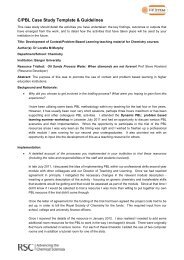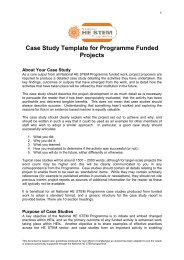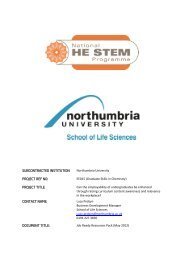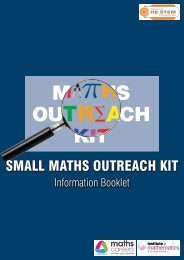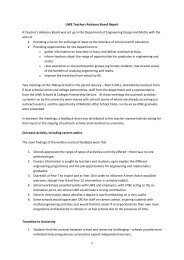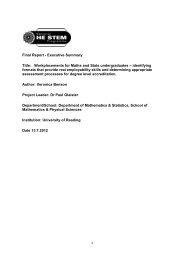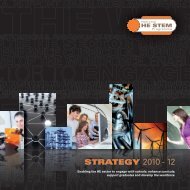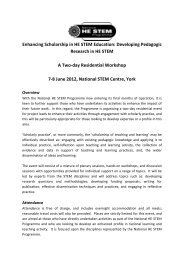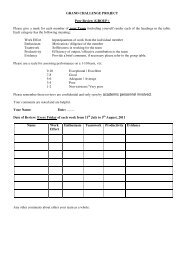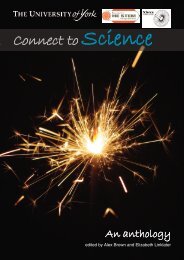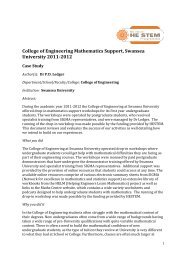A case study approach to large-group teaching of level 4 electronics ...
A case study approach to large-group teaching of level 4 electronics ...
A case study approach to large-group teaching of level 4 electronics ...
You also want an ePaper? Increase the reach of your titles
YUMPU automatically turns print PDFs into web optimized ePapers that Google loves.
A <strong>case</strong> <strong>study</strong> <strong>approach</strong> <strong>to</strong> <strong>large</strong>-<strong>group</strong> <strong>teaching</strong> <strong>of</strong> <strong>level</strong> 4<br />
<strong>electronics</strong> <strong>to</strong> engineering students from other disciplines<br />
A. Sut<strong>to</strong>n and G. Charles<br />
School <strong>of</strong> Mechanical and Manufacturing Engineering<br />
Loughborough University<br />
Abstract<br />
This <strong>case</strong> <strong>study</strong> describes a project in which we aimed <strong>to</strong> contextualise the <strong>teaching</strong> <strong>of</strong> <strong>electronics</strong><br />
<strong>to</strong> a <strong>large</strong> student <strong>group</strong> that does not major in in the discipline through a <strong>case</strong> <strong>study</strong> design<br />
<strong>approach</strong> developed across the entire module. The target circuit design measures mechanical<br />
force or load - important phenomena in the students’ core <strong>study</strong> area. Design ideas and analysis<br />
<strong>to</strong>ols are introduced as required <strong>to</strong> progress the design rather than being <strong>group</strong>ed <strong>to</strong>wards the front<br />
<strong>of</strong> the <strong>teaching</strong> as is <strong>of</strong>ten the <strong>case</strong>. A pilot <strong>study</strong> has been completed and a <strong>large</strong> <strong>group</strong> activity is<br />
currently underway.<br />
Keywords: <strong>large</strong>-<strong>group</strong> <strong>teaching</strong>, cross-disciplinary, <strong>electronics</strong><br />
Background<br />
This project came about as a result <strong>of</strong> several years spent <strong>teaching</strong> <strong>electronics</strong> <strong>to</strong> both <strong>level</strong> 4<br />
undergraduate and postgraduate students enrolled on IMechE accredited degree programmes<br />
within the School <strong>of</strong> Mechanical and Manufacturing Engineering at Loughborough University. This<br />
project is predominantly aimed at the 220-230 undergraduate students attracted by the School<br />
each year across a mix <strong>of</strong> degree programmes, with typical <strong>of</strong>fers <strong>of</strong> A*AA at for MEng and ABB<br />
for BEng. The Mechanical Engineering course attracts approximately 155 mixed MEng/BEng<br />
students, with the remainder spread across the Product Design Engineering, Manufacturing<br />
Engineering, Engineering Management, Innovative Manufacturing Engineering and Sports<br />
Technology programmes. All students <strong>study</strong> <strong>electronics</strong> and electrical power during their degree<br />
and typically display little interest as it is perceived <strong>to</strong> be unimportant <strong>to</strong> a student specialising in a<br />
different discipline. In some <strong>case</strong>s they are actually hostile <strong>to</strong> the idea.<br />
Rationale<br />
Student engagement is widely known <strong>to</strong> be an issue in HE, with an ever-increasing <strong>level</strong> <strong>of</strong> student<br />
attrition (Roberts and McNeese, 2010). Many institutions struggle <strong>to</strong> take student retention<br />
seriously (Tin<strong>to</strong>, 2009) and <strong>to</strong> translate what they know in<strong>to</strong> actions that improve engagement and<br />
retention. Lack <strong>of</strong> engagement in the <strong>study</strong> <strong>of</strong> <strong>electronics</strong> within our school is a perennial problem<br />
that we hope <strong>to</strong> address with this project.<br />
The problems we face are really tw<strong>of</strong>old: <strong>teaching</strong> a non-core subject <strong>to</strong> students who really do not<br />
see the need <strong>to</strong> learn this material and <strong>teaching</strong> the subject <strong>to</strong> <strong>large</strong> number <strong>of</strong> students (circa 200)<br />
with differing backgrounds and entry qualifications. Additionally, the <strong>teaching</strong> methods need <strong>to</strong><br />
consider the students’ differing preferred learning styles (Kolb, 1971) and <strong>of</strong>fer a broad range <strong>of</strong><br />
learning opportunities and experiences as well as a demonstrable relevance <strong>to</strong> what we teach.<br />
Reinforcing mathematically and conceptually complex material <strong>to</strong> potentially uninterested and<br />
unmotivated students presents significant challenges. Contextualising content and developing a<br />
clear sense <strong>of</strong> relevance in real situations (Yilmaz, 1996) through real world <strong>case</strong> <strong>study</strong> design and<br />
application <strong>of</strong> theory in a labora<strong>to</strong>ry environment is felt <strong>to</strong> be key <strong>to</strong> developing motivation and<br />
1
engagement. The introduction <strong>of</strong> open-ended, student-centred simulation exercises also provides<br />
a significant opportunity for <strong>level</strong> 4 students <strong>to</strong> practice au<strong>to</strong>nomy and time management in their<br />
learning. For new students it can be difficult <strong>to</strong> shed the rote style <strong>of</strong> learning <strong>to</strong> which they have<br />
become accus<strong>to</strong>med during A <strong>level</strong> <strong>study</strong> and move <strong>to</strong>ward a broader vision <strong>of</strong> retention and<br />
transfer where they are able <strong>to</strong> both acquire knowledge and apply it <strong>to</strong> a variety <strong>of</strong> situations<br />
(Mayer, 2002). Students in the school have <strong>to</strong> complete a project every year, most <strong>of</strong> which contain<br />
some <strong>electronics</strong> element.<br />
Much <strong>of</strong> the favoured pedagogy in textbooks is quite unnecessary and is not used by practising<br />
engineers, while useful circuits and methods <strong>of</strong> analysis lie deeply hidden (Horrowitz and Hill,<br />
1989). Our aim was <strong>to</strong> teach non-subject specific students <strong>to</strong> be able <strong>to</strong> ‘do <strong>electronics</strong>’ (ibid.), a<br />
useful skill for their further studies.<br />
The <strong>approach</strong><br />
Initially the project’s aim was <strong>to</strong> develop an innovative <strong>teaching</strong> strategy for a <strong>large</strong> <strong>group</strong> <strong>of</strong><br />
students. Several fac<strong>to</strong>rs, including university restructuring, a new management structure within<br />
the school itself and a subsequent <strong>teaching</strong> review across all programmes, resulted in the original<br />
target <strong>group</strong> module being no longer available. The focus then shifted <strong>to</strong> a different <strong>large</strong> <strong>group</strong><br />
<strong>electronics</strong> module which would not run until semester 2 <strong>of</strong> 2011/12. A pilot <strong>study</strong> with a smaller<br />
<strong>group</strong> <strong>of</strong> students, based around the same <strong>teaching</strong> philosophy, has been developed and delivered<br />
and the <strong>large</strong> <strong>group</strong> <strong>teaching</strong> has also been developed and is currently being delivered.<br />
A significant issue when <strong>teaching</strong> <strong>electronics</strong> <strong>to</strong> non-subject specific undergraduates is the breadth<br />
<strong>of</strong> the subject and the state <strong>of</strong> the art within the field. Modern <strong>electronics</strong> systems tend <strong>to</strong> be<br />
developed around microcomputers running programmes and <strong>large</strong>-scale integrated circuits with<br />
design representations downloaded from a PC, abstracting the hardware from the functionality and<br />
possibly “hiding” the physical <strong>electronics</strong> from the student. A significant concern here was that a<br />
digital <strong>electronics</strong> exercise could very easily be seen by students as simply one <strong>of</strong> writing code.<br />
Several <strong>case</strong> <strong>study</strong> ideas were generated, with the promotion and development <strong>of</strong> student<br />
engagement as the defining philosophy. We elected <strong>to</strong> focus on either an instrumentation system<br />
designed <strong>to</strong> measure some common physical phenomenon or some form <strong>of</strong> controlled drive<br />
system <strong>to</strong> move a load, both <strong>of</strong> which are relevant <strong>to</strong> the students’ core areas <strong>of</strong> <strong>study</strong>.<br />
Table 1. A selection <strong>of</strong> the initial ideas for possible adoption as the <strong>case</strong> <strong>study</strong> design exercise<br />
Phenomenon<br />
Measuring shaft rotation/displacement<br />
Measuring weight/force<br />
Measuring temperature<br />
Measuring pressure<br />
DC mo<strong>to</strong>r speed positioning <strong>of</strong> a load<br />
Stepper mo<strong>to</strong>r positioning <strong>of</strong> a load<br />
Control <strong>of</strong> mass-spring-damper system<br />
Discipline bias<br />
Digital/processor<br />
Predominantly analogue + processing?<br />
Predominantly analogue + processing?<br />
Predominantly analogue + processing?<br />
Mixed mode using PWM or DAC + amplifier<br />
Predominantly digital with discrete components<br />
Predominantly digital/processor<br />
Several <strong>case</strong> studies were evaluated in terms <strong>of</strong> educational value, desired discipline bias,<br />
relevance <strong>to</strong> the student’s core discipline, engineering depth, health and safety, and ease <strong>of</strong><br />
development <strong>of</strong> <strong>teaching</strong> apparatus. An early outcome was <strong>to</strong> focus predominantly on analogue<br />
<strong>electronics</strong> and the majority <strong>of</strong> analogue <strong>case</strong> <strong>study</strong> ideas were instrumentation-based. A decision<br />
was taken <strong>to</strong> develop a system <strong>to</strong> measure some physical phenomenon, but <strong>to</strong> incorporate<br />
flexibility, creating a “universal” instrumentation system which could be easily modified <strong>to</strong> work with<br />
a range <strong>of</strong> sensors.<br />
Two phenomena were shortlisted: temperature and force or weight. Given the desire <strong>to</strong> minimise<br />
health and safety concerns, a simple weighing system was adopted, based around a low-priced,<br />
2
600g maximum load, single point load cell (RS Components part number 414-0843 – see Figure<br />
1).<br />
Figure 1. 25 load cells purchased for the project<br />
Sets <strong>of</strong> kitchen scales weights were purchased and, upon checking against references in our<br />
Metrology labora<strong>to</strong>ry, were found <strong>to</strong> be suitably accurate <strong>to</strong> within ±0.1g.<br />
Figure 2. A load cell mounted and ready for use with the test weights<br />
An important aspect <strong>of</strong> the module philosophy was <strong>to</strong> facilitate as much hands-on application <strong>of</strong><br />
theory as practicable, while still ensuring adequate time for thinking, experimentation and<br />
consolidation <strong>of</strong> theory. It is all <strong>to</strong>o easy <strong>to</strong> overload students with <strong>to</strong>o much build-up and<br />
connection <strong>of</strong> the apparatus and leave <strong>to</strong>o little time for actual learning.<br />
National Instruments (NI), a multinational measurement and instrumentation company, strongly<br />
supports <strong>teaching</strong> in universities through their dedicated academic team. NI recently released their<br />
latest <strong>electronics</strong> <strong>teaching</strong> platform, the ELVIS II (Educational Labora<strong>to</strong>ry Virtual Instrumentation<br />
Suite), incorporating removable and low-priced pro<strong>to</strong>typing plugblock boards in<strong>to</strong> which component<br />
leads may be inserted <strong>to</strong> quickly construct simple circuit arrangements. The system also features<br />
an integrated suite <strong>of</strong> 12 commonly used instruments, including an oscilloscope, digital multimeter,<br />
function genera<strong>to</strong>r, variable power supply and Bode analyser. Based on NI’s LabVIEW graphical<br />
system design s<strong>of</strong>tware, NI ELVIS, with USB plug-and-play capabilities, <strong>of</strong>fers the flexibility <strong>of</strong><br />
virtual instrumentation and allows for quick and easy measurement and display (National<br />
Instruments, n.d.).<br />
Virtual instruments provide many benefits for <strong>large</strong> <strong>group</strong> <strong>teaching</strong>, not least <strong>of</strong> which is the<br />
absence <strong>of</strong> the need <strong>to</strong> connect a host <strong>of</strong> long wires <strong>to</strong> the circuit under test, something which<br />
typically accounts for a <strong>large</strong> proportion <strong>of</strong> the time spent on a labora<strong>to</strong>ry exercise. The uniform<br />
design and appearance <strong>of</strong> the virtual controls also facilitates rapid familiarity with all instruments.<br />
3
25 ELVIS II units were purchased in 2011 for use on the <strong>large</strong> <strong>group</strong> module, along with an<br />
agreement for NI <strong>to</strong> provide appropriate training, development and assistance in the development<br />
<strong>of</strong> labora<strong>to</strong>ry exercises.<br />
Figure 3. NI ELVIS II unit showing simple inverting amplifier circuit<br />
Figure 4. Virtual function genera<strong>to</strong>r and oscilloscope<br />
With a <strong>case</strong> <strong>study</strong> design in place, a syllabus was developed that started with the traditional<br />
introduc<strong>to</strong>ry subjects and developed ideas and theory <strong>to</strong>wards the final design. Traditionally,<br />
textbooks and courses <strong>of</strong>ten introduce a range <strong>of</strong> theory and analysis <strong>to</strong>ols early in the learning<br />
before moving on <strong>to</strong> look at the components and circuit design <strong>to</strong> which the theory is actually<br />
applied, by which time much <strong>of</strong> it may already be forgotten. With an emphasis on contextualising<br />
the learning, it was deemed better <strong>to</strong> provide the most basic analysis <strong>to</strong>ols early in the learning and<br />
introduce more sophisticated and complex methods (such as Thevenin’s theory, superposition<br />
etc.) only when required <strong>to</strong> understand the operation <strong>of</strong> a <strong>case</strong> <strong>study</strong> circuit element.<br />
For the small <strong>group</strong> pilot <strong>study</strong> module, it was decided <strong>to</strong> extend and deepen some <strong>of</strong> the original<br />
ideas beyond the <strong>large</strong> <strong>group</strong> module plan and use this as a basis for evaluation <strong>of</strong> what could<br />
realistically be included in a module on which 200+ students are enrolled. This additional depth<br />
included basic Spice simulation exercises both in the labora<strong>to</strong>ry and as student-centred learning.<br />
Simulations were also run during lecture sessions, with students asked <strong>to</strong> draw predicted output<br />
waveforms before the circuit simulation was run over a data projec<strong>to</strong>r; a very successful activity,<br />
promoting good <strong>level</strong>s <strong>of</strong> engagement and interaction. Simulation s<strong>of</strong>tware licenses were<br />
purchased for the labora<strong>to</strong>ry, but students had <strong>to</strong> use time-limited demonstration copies when<br />
working on their own. A second order active filter and a three op-amp instrumentation amplifier<br />
were also included in the design, along with discussion <strong>of</strong> good layout and low noise design<br />
principles. Material left out <strong>of</strong> the <strong>large</strong> <strong>group</strong> module has subsequently been integrated in<strong>to</strong> a <strong>level</strong><br />
6 instrumentation module where the <strong>level</strong> 4 <strong>case</strong> <strong>study</strong> is revisited and explored, providing<br />
deepening across modules.<br />
The final small <strong>group</strong> <strong>case</strong> <strong>study</strong> circuit design is shown in Figure 5 and comprises a load cell<br />
connected <strong>to</strong> an instrumentation amplifier, followed by a second order Sallen and key filter and<br />
finally an analogue-<strong>to</strong>-digital converter (ADC). As the focus <strong>of</strong> the module is the analogue portion<br />
<strong>of</strong> the system, the ADC was implemented as part <strong>of</strong> a microcontroller which allowed the raw binary<br />
4
and converted weight value <strong>to</strong> be displayed on an alphanumeric display and also sent down an<br />
RS232 cable for display in HyperTerminal if desired.<br />
Figure 5. Final <strong>case</strong> <strong>study</strong> circuit design used on the small <strong>group</strong> exercise<br />
With no ELVIS units available for the small <strong>group</strong> exercise, printed circuit boards (PCBs) with the<br />
facility <strong>to</strong> isolate sections and test points <strong>to</strong> measure section outputs were produced in-house.<br />
Additional circuitry was included <strong>to</strong> allow students <strong>to</strong> measure the cut-<strong>of</strong>f frequency <strong>of</strong> the filter.<br />
Labora<strong>to</strong>ry sessions run with these boards were very successful, but it was felt that students didn’t<br />
get the same “connection” <strong>to</strong> the circuit as when building it up themselves on ELVIS.<br />
A significant advantage <strong>of</strong> using the pre-built boards was the facilitation <strong>of</strong> an additional faultfinding<br />
labora<strong>to</strong>ry session. A second set <strong>of</strong> boards had intentional faults introduced, including<br />
unsoldered pins, hairline breaks in tracks, components <strong>of</strong> incorrect value and a diode inserted the<br />
wrong way round (the diode was included in the circuit design solely for this purpose).<br />
Figure 6. PCB layout for the small <strong>group</strong> <strong>case</strong> <strong>study</strong> and experimental setup<br />
The final syllabus (analogue portion – some digital <strong>electronics</strong> was also taught) adopted for the<br />
small <strong>group</strong> <strong>case</strong> <strong>study</strong>-based <strong>teaching</strong> is shown in Table 2.<br />
Table 2. Curriculum used when <strong>teaching</strong> the small <strong>group</strong> exercise<br />
1. Introduction <strong>to</strong> typical<br />
labora<strong>to</strong>ry instruments<br />
2. Introduction <strong>to</strong> signals<br />
and analogue<br />
<strong>electronics</strong><br />
3. Ohms law, power,<br />
resis<strong>to</strong>rs, capaci<strong>to</strong>rs,<br />
series, parallel<br />
4. Nodal and mesh,<br />
networks, impedance<br />
5
4. Introduction <strong>to</strong> 5. Transis<strong>to</strong>rs, switches 6. Strain gauge, load 7. Kirchh<strong>of</strong>f, introduction<br />
semiconduc<strong>to</strong>rs, diodes, and common emitter cell, Wheats<strong>to</strong>ne bridge, <strong>to</strong> amplifiers, inverting,<br />
bridge circuits amplifier<br />
Thevenin, impedance<br />
matching<br />
non-inverting, summing,<br />
compara<strong>to</strong>r<br />
9. Filters, Sallen and<br />
key, second order low<br />
and high pass<br />
8. Superposition,<br />
differential amplifiers,<br />
instrumentation<br />
amplifiers<br />
10. Bringing it all<br />
<strong>to</strong>gether, block diagram<br />
and circuit shape<br />
11. Final design<br />
calculations, extension<br />
<strong>to</strong> measuring other<br />
phenomena<br />
N.B. The numbered sections in the table do not necessarily refer <strong>to</strong> a single lecture/tu<strong>to</strong>rial on the<br />
subject, but show the demarcation between sections. Black text signifies both small and <strong>large</strong><br />
<strong>group</strong> exercises, blue text small <strong>group</strong> only.<br />
The overriding issue with the development <strong>of</strong> the <strong>large</strong> <strong>group</strong> <strong>teaching</strong> exercise is labora<strong>to</strong>ry<br />
throughput. Even with the adoption <strong>of</strong> the ELVIS II, virtual instrumentation and students working in<br />
pairs, each labora<strong>to</strong>ry exercise must be repeated five times (with all associated timetabling and<br />
staffing issues). For the small <strong>group</strong> exercise, each labora<strong>to</strong>ry session ran only once.<br />
To reduce the circuit assembly time during <strong>large</strong> <strong>group</strong> ELVIS-based labora<strong>to</strong>ry exercises, the<br />
signal amplification stage was reduced <strong>to</strong> a simple differential amplifier with unity gain buffers and<br />
the second order active filter was removed. With reduced labora<strong>to</strong>ry time per student, and a limited<br />
number <strong>of</strong> simulation licences, the simulation exercises were also removed.<br />
Table 3. Labora<strong>to</strong>ry exercises undertaken by students on the small <strong>group</strong> module<br />
1. Introduction <strong>to</strong> B 2<br />
Spice simulation<br />
s<strong>of</strong>tware<br />
5. Simulation <strong>of</strong> final<br />
<strong>case</strong> <strong>study</strong> design<br />
2. Spice simulation <strong>of</strong><br />
resis<strong>to</strong>r and RC circuits<br />
6. Measurements on<br />
individual stages <strong>of</strong><br />
physical circuit<br />
3. Spice simulation <strong>of</strong><br />
basic amplifier circuits<br />
7. Measurements <strong>of</strong><br />
overall system outputs<br />
4. Simulation <strong>of</strong><br />
differential amplifiers<br />
8. Fault-finding exercise<br />
Table 4. Labora<strong>to</strong>ry exercises undertaken by students on the <strong>large</strong> <strong>group</strong> module<br />
1. Resis<strong>to</strong>rs, series and<br />
parallel, networks,<br />
Thevenin<br />
2. Signals, common<br />
emitter amplifiers<br />
3. Basic operational<br />
amp circuits<br />
4. Case <strong>study</strong> circuit,<br />
measurement <strong>of</strong> system<br />
outputs<br />
It is hoped that, as experience with the new module format and ELVIS units develops over the next<br />
two <strong>to</strong> three years, the <strong>large</strong> <strong>group</strong> exercises may be extended <strong>to</strong> include additional depth and<br />
content <strong>to</strong> align them closer with the small <strong>group</strong> pilot <strong>study</strong>.<br />
Assessment<br />
The assessment retains a two-hour written examination at the end <strong>of</strong> the semester which carries<br />
70% <strong>of</strong> the overall marks. Questions take various forms, including drawing a small circuit diagram,<br />
deriving equations (amplifier gains, bridge output, etc.), carrying out typical circuit design<br />
calculations, describing the operation <strong>of</strong> circuit fragments, identifying which <strong>of</strong> several circuit<br />
configurations would give a stated output, determining component values for a given circuit<br />
diagram, etc.<br />
Typically, each question follows the format:<br />
a) Show learning from <strong>teaching</strong> material and reading around the subject<br />
b) Demonstrate depth <strong>of</strong> understanding <strong>of</strong> the material<br />
c) Carry out appropriate calculation(s) and/or analyse a circuit fragment.<br />
The first element <strong>of</strong> the coursework assessment was formative and <strong>to</strong>ok place after the initial <strong>case</strong><br />
<strong>study</strong> circuit shape was presented without component values. Students were asked <strong>to</strong> calculate<br />
suitable component values for the circuit in their own time. Component values were then derived<br />
6
during a two-hour lecture slot in a very informal way, with discussion encouraged where students’<br />
values varied from those <strong>of</strong> the lecturing staff. This was very valuable in encouraging the students<br />
<strong>to</strong> understand how design decisions are taken and that there is <strong>of</strong>ten not “a” correct value.<br />
The second formative assessment was the addition <strong>of</strong> a small, relatively informal, viva voce style<br />
discussion and feedback session in the labora<strong>to</strong>ry at the end <strong>of</strong> the final labora<strong>to</strong>ry exercise.<br />
The third assessment was carried out summatively during the two-hour fault-finding labora<strong>to</strong>ry<br />
exercise and was based around a simple algorithm allocating a non-linear award <strong>of</strong> marks which<br />
correlated <strong>to</strong> the number <strong>of</strong> correctly identified faults. The <strong>large</strong> <strong>group</strong> exercise does not include<br />
this assessment point.<br />
The final coursework deliverable was a ten-page report <strong>to</strong> demonstrate the students’<br />
understanding <strong>of</strong> the final <strong>case</strong> <strong>study</strong> design system and the underpinning theory, making<br />
reference <strong>to</strong> their design calculations, simulation results and actual measurements. Students were<br />
also asked <strong>to</strong> discuss which <strong>of</strong> these values they would have the most confidence in and possible<br />
sources <strong>of</strong> errors. Worryingly, many had more confidence in simulation than actual measurement!<br />
Evaluation<br />
The <strong>large</strong> <strong>group</strong> <strong>study</strong> exercise is currently running but the small <strong>group</strong> exercise has been run and<br />
is discussed here.<br />
The examination average <strong>of</strong> 54.57% was 3% above the average <strong>of</strong> the preceding four years, with<br />
the highest individual score ever seen on this module (88%). The quality <strong>of</strong> answers was improved<br />
over previous years. In this era <strong>of</strong> student “revision” relying on past papers, the paper format may<br />
have caused some confusion. It is also common <strong>to</strong> see low grades after major changes and we are<br />
optimistic that grades will rise significantly as the module matures and past papers become<br />
available.<br />
Student feedback on the module was the highest ever received, with questions such as “the<br />
module developed my understanding <strong>of</strong> the subject” and “overall I would rate this module highly”<br />
scoring 4.27 out <strong>of</strong> 5. Individual lecturer scores were 4.76 and 4.78 out <strong>of</strong> 5, suggesting that<br />
students were more engaged with the material than in previous incarnations. Staff involved in the<br />
small <strong>group</strong> module felt that the students demonstrated a better understanding <strong>of</strong> the material (a<br />
view supported anecdotally by several staff who volunteered their agreement). Module staff also<br />
found the format more enjoyable <strong>to</strong> teach, a fact which was reflected in the high individual<br />
feedback scores.<br />
A short questionnaire was circulated <strong>to</strong> students who had previously studied the <strong>large</strong> <strong>group</strong><br />
module. Although only 11% responded, some useful insight in<strong>to</strong> the students’ view <strong>of</strong> the school’s<br />
<strong>electronics</strong> <strong>teaching</strong> was gained, much <strong>of</strong> which supported our own views.<br />
The key points <strong>to</strong> come out <strong>of</strong> the questionnaire delivered <strong>to</strong> the previous <strong>group</strong> <strong>of</strong> students are:<br />
Students gained a better understanding <strong>of</strong> the digital material than the analogue<br />
Students would like <strong>to</strong> revisit lectures through online video<br />
Students felt that the coursework content <strong>of</strong> the original module (a class test) was poor and<br />
didn’t help <strong>to</strong> develop their understanding <strong>of</strong> the subject at all<br />
In response <strong>to</strong> the question “Do you feel that you could now design your own simple electronic<br />
circuits?” the response was very negative, with a typical reply being ‘No. I gained very little<br />
from the module’<br />
Students reported that they found the module very difficult <strong>to</strong> engage with<br />
Students felt that the module was ‘completely useless, with no practical application and not<br />
linked <strong>to</strong> mechanical engineering or any other engineering systems’<br />
Students felt that ‘it was boring - no practical application, no real variation’.<br />
The <strong>large</strong> <strong>group</strong> module is currently in its third week <strong>of</strong> <strong>teaching</strong> and the questionnaire will be<br />
circulated <strong>to</strong> the current cohort at the end <strong>of</strong> the module <strong>to</strong> help gauge its success and feed in<strong>to</strong><br />
future developments.<br />
7
Discussion, summary<br />
University and school restructuring caused several issues, resulting in the change <strong>to</strong> a different<br />
<strong>large</strong> <strong>group</strong> <strong>electronics</strong> module. However, significant changes have been made <strong>to</strong> the way we<br />
<strong>approach</strong> <strong>electronics</strong> <strong>teaching</strong>. Several tens <strong>of</strong> thousands <strong>of</strong> pounds were spent on new equipment<br />
<strong>to</strong> support this <strong>teaching</strong> and overall the project is deemed <strong>to</strong> have been a success, with<br />
considerable promise for the future as it grows.<br />
The small <strong>group</strong> <strong>teaching</strong> exercise was very successful, with improved student engagement and,<br />
significantly, more interest shown in the material. Staff also found the new <strong>approach</strong> <strong>to</strong> delivering<br />
the material more satisfying and rewarding, seeing students generally developing a better intuitive<br />
feel for the subject. A higher <strong>level</strong> <strong>of</strong> interaction was achieved between staff and students,<br />
particularly during simulation exercises carried out during lecture sessions.<br />
Students didn’t get <strong>to</strong> build up the circuits on the small <strong>group</strong> exercise, developing less “feel” for<br />
the actual components. The <strong>large</strong> <strong>group</strong> exercise tackles this with the use <strong>of</strong> the ELVIS unit, but<br />
the trade-<strong>of</strong>f is the loss <strong>of</strong> the fault-finding exercise and a reduction in the complexity <strong>of</strong> the <strong>case</strong><br />
<strong>study</strong> design. Another drawback <strong>to</strong> the use <strong>of</strong> ELVIS is the loss <strong>of</strong> student interaction with a PCB. It<br />
is hoped that, as the <strong>large</strong> <strong>group</strong> module matures, it will be possible <strong>to</strong> develop methods <strong>of</strong><br />
incorporating these missing elements.<br />
The contextualisation <strong>of</strong> analytical techniques by their introduction only when necessary <strong>to</strong><br />
understand a circuit section was also very successful and students were able <strong>to</strong> answer<br />
examination questions using these techniques more knowledgeably and comprehensively than in<br />
previous years.<br />
Further development<br />
Once the results <strong>of</strong> the <strong>large</strong> <strong>group</strong> exercise are known it is hoped that the module can be<br />
developed <strong>to</strong> include some simulation exercises which might possibly form part <strong>of</strong> the coursework.<br />
The key issue here is <strong>to</strong> identify a simulation package that can be licensed for students <strong>to</strong> use on<br />
their own computers or at least across all <strong>of</strong> the main campus computing rooms. There is a<br />
possibility that this may become computer-assessed, with some form <strong>of</strong> student feedback<br />
au<strong>to</strong>matically generated.<br />
With familiarity with the ELVIS system and the new <strong>teaching</strong> format, the <strong>large</strong> <strong>group</strong> <strong>case</strong> <strong>study</strong><br />
design may be extended <strong>to</strong> include an active filter in the signal path (as used in the small <strong>group</strong><br />
exercise).<br />
Under discussion is a hybrid <strong>approach</strong> where small sub-circuits are plugged in<strong>to</strong> the ELVIS unit,<br />
facilitating the incorporation <strong>of</strong> all small <strong>group</strong> exercises in<strong>to</strong> the <strong>large</strong> <strong>group</strong> <strong>teaching</strong>. An<br />
alternative would be <strong>to</strong> purchase enough plug-in development boards for each student pair <strong>to</strong><br />
retain one across all labora<strong>to</strong>ry exercises, negating the need <strong>to</strong> dismantle circuits between<br />
exercises.<br />
References<br />
Horrowitz, P. and Hill, W. (1989) The Art <strong>of</strong> Electronics, 2 nd edition, Cambridge, Cambridge<br />
University Press.<br />
Kolb, D. A. (1971) Individual learning styles and the learning process. Working Paper #535-71,<br />
Bos<strong>to</strong>n, Sloan School <strong>of</strong> Management, Massachusetts Institute <strong>of</strong> Technology.<br />
Mayer, R. E. (2006) ‘Rote versus Meaningful Learning’, Theory and Practice, vol. 41, no. 4, pp.<br />
226-232.<br />
National Instruments (n.d.) NI ELVIS II, NI ELVIS II+ Instrumentation, Design and Pro<strong>to</strong>typing<br />
Platform [online], http://sine.ni.com/nips/cds/view/p/lang/en/nid/13137 (Accessed 8 April 2012).<br />
Roberts, J., and McNeese, M. N. (2010) ‘Student Involvement/Engagement in Higher Education<br />
Based on Student Origin’, Research in Higher Education Journal, vol. 7, pp. 1-11.<br />
Tin<strong>to</strong>, V. (2009) ‘Taking Student Retention Seriously: Rethinking the First Year <strong>of</strong> University’,<br />
Keynote speech delivered at the ALTC FYE Curriculum Design Symposium, Brisbane, Australia, 5<br />
February 2009, Queensland University <strong>of</strong> Technology, Brisbane, Australia.<br />
8
Yilmaz, M. R. (1996) ‘The Challenge <strong>of</strong> Teaching Statistics <strong>to</strong> Non-Specialists’, Journal <strong>of</strong> Statistics<br />
Education, vol. 4, no.1.<br />
Publication Date: 30/04/2012<br />
This work is licensed under a Creative Commons Attribution-NoDerivs 3.0<br />
Unported License<br />
9




